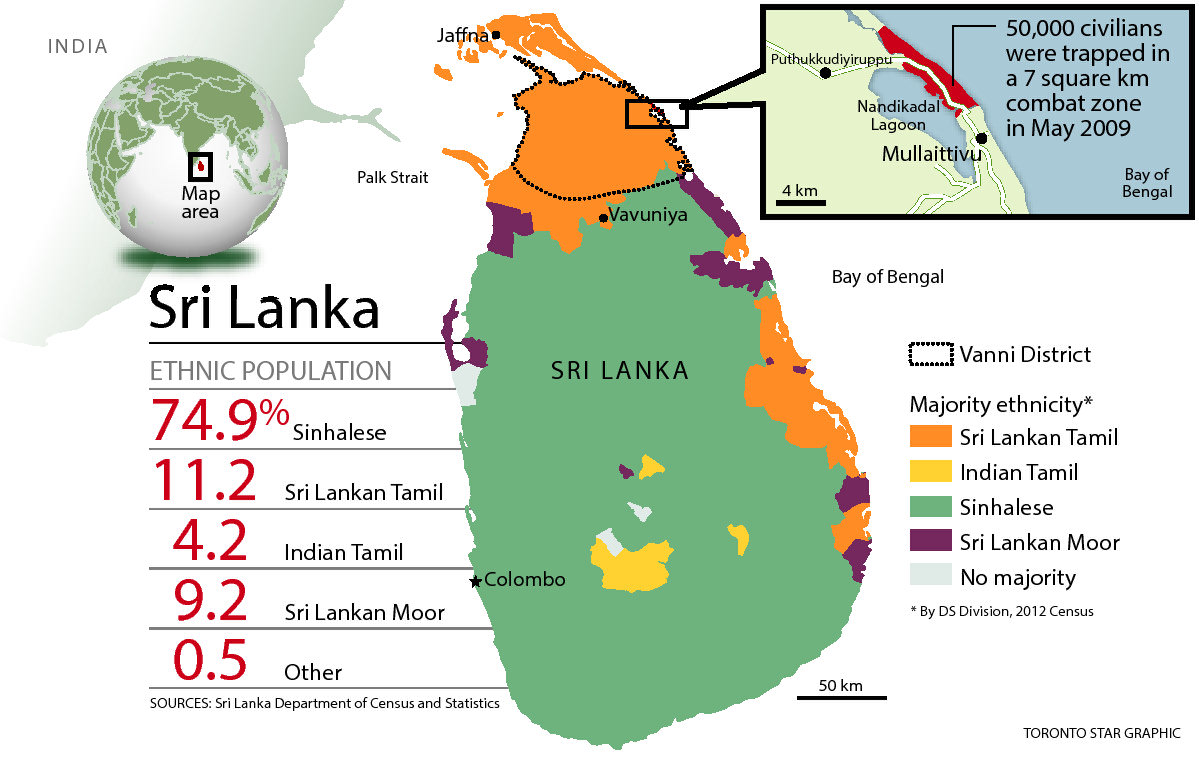
The Sinhala/Tamil relations and the ethnic conflict intensified immediately after the independence of the Island on February 04, 1948. The rise of Tamil nationalism is not entirely a new phenomenon but only resurgence. The institutionalization and entrenched structure of genocide of Tamils since independence is the main cause of the conflict that caused the deaths of 70,000 civilians according to UN estimate and more than 147,000 as estimated by Father Rayappu Joseph calculating from the Government records in the Census Department and the recorded of people returned to the District after the war.
Sri Lanka was granted independence [1948], by the British. Immediately after the British handed over the country to the majoritarian Sinhala Buddhist leaders where the Tamils were at the receiving end.
It should be noted that the Tamils Kingdom of Jaffna flourished for more than 800 years before the arrival of Portuguse in 1621, at that time three Kingdoms existed in Sri Lanka [then Ceylon]
- Kotte Kingdom [Sinhalese Kings ruled]
- Kandy Kingdom [Sinhalese Kings ruled]
- Jaffna Kingdom of [Tamil Kings ruled[
The Portuguese ruled Sri Lanka as three units from 1621 to 1658
The Dutch ruled Sri Lanka as three units from 1658 to 1795
The British ruled Sri Lanka as three units from 1795 to 1833 and in 1833 the British amalgamated the three units as one unit for their easy administration. And ruled until independence in 1948.
Unfortunately the British handed over the entire administration [including the Tamils Jaffna Kingdom] to the majoritarian Sinhala Buddhist political leaders
Since then the following discriminatory acts have taken place.
1.State sponsored colonization of Sinhala Buddhist into the Hindu/Christians homeland to change the demography of the Jaffna Kingdom
- State sponsored pogroms against the Tamils in 1956, 1958, 1971, 1977 1983 where the Tamils were targeted, killed, raped and the Tamils houses, establishments looted and set on fire
- Burning of Jaffna library. On May 31, 1981: At its time one of the largest and best equipped ones in South Asia which housed 97,000 rare books, and manuscripts.
- The Official language of the country was English for many years until 1956, and from 1956 the Sinhala majoritarian Sinhala Buddhist rulers declared Sinhala language as the Official Language without any safeguard to the Tamils who never studied Sinhalese language before.Several peaceful non-violent struggles, agitation for language policy and against colonization were met with brutal military force,
- Due to continuing state sponsored colonization under the guise of irrigation schemes, they have made drastic changes in the demography of Tamils traditional homeland, especially the Eastern province.
- Buddhism as State Religion: The Buddhist clergy, Maha Sanga, racist Sinhala Buddhist leaders have been working under an agenda to make Sri Lanka A BUDDHIST SINHALESE STATE.
With legal powers in the Constitution of Sri Lanka to protect and foster Buddhist religion the Archaeological Department [mostly Sinhala Buddhist officials] claims the existing Hindu Temples were Buddhist sites and some Hindu temples were demolished and Buddhist temples were built in these places where Hindu Tamils live. In addition to this the Forest Department, Irrigation Department takes sides and gives preference to Sinhala Buddhist civilians.
Due to the failure of the British to hand over the Jaffna Kingdom back to the Tamils and handing over the entire powers to the majoritarian Sinhala leaders without any foresight and without any protection to the Tamils belonged to Jaffna Kingdom, the Tamils are now at the receiving end since Independence in 1948/
The present British Government and the people of Great Britain at least at this critical time must think of the Tamils endless sufferings and find REMEDIAL JUSTICE to the oppressed Tamils in Sri Lanka. The British Government and the Commonwealth must think of the plight of the Tamils sufferings due to their failure to hand over the Jaffna Kingdom to the Tamils.
The disturbing feature of Sri Lanka’s post independence is the organized violence in the form of anti-Tamil riots and pogroms periodically unleashed on the Tamil people in 1956, 1958, 1961, 1977, 1981 and 1983, The last in 1983 referred as ‘Holocaust’ or: Black July 1983” witnessed over 3000Tamils killed and billions of rupees worth of their properties and business establishments destroyed.
State-aided colonization with Sinhalese settlers in the North and East of the country has since independence; this is intended to change the demographist in these two provinces and to break the contiguity between them so as to deny the Tamils’ demand for a separate state for them. The Sinhalese population in the Eastern province which was mere 4% at the time of independence is today estimated at 26%.
Tamil villages have been taken over in the Eastern and Northern Provinces by driving away the Tamils who have lived there for generations. This has been followed by changing the Tamil names to Sinhala names. The foremost example is the Manal Aru, today known by its Sinhala name of Weli Oya. Weli Oya has now been designated and gazetted as a Sinhala Divisional Secretariat in the Mullaitivu District. The creation of Weli Oya has also helped to break the continuity between Northern and Eastern Provinces.
This is pure and simple an example of ethnic cleansing.
Kumarathasan Rasingam, Secretary, Tamil Canadian Elders for Human Rights Org.
 RSS Feed
RSS Feed















 July 15th, 2021
July 15th, 2021  Awake Goy
Awake Goy  Posted in
Posted in  Tags:
Tags: 













